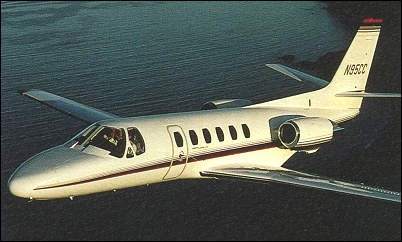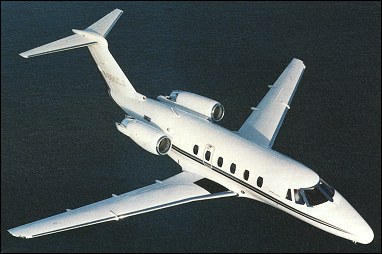 |
Cessna Model 500 Citation1969 |  |
| EXECUTIVE TRANSPORT | Virtual Aircraft Museum / USA / Cessna |
 |
The Cessna Citation, announced in 1968, was one of the first of the new generation of turbofan-powered business jets, a response to growing pressure from environmentalists for quieter engines and from operators for better fuel economy. Its development represented a very large investment for the company, but when the prototype Fanjet 500 (as it was then named) flew for the first time on 15 September 1969, it posed a serious commercial threat to aircraft such as the D.H.125, Falcon 20, Learjets and Sabreliner which had dominated the market to that time. Renamed the Model 500 Citation shortly after the first flight, the eight-seat Model 500 has an overall configuration similar to that of earlier Cessna twins except for its powerplant installation. This featured two 990kg Pratt & Whitney Canada JT15D-1 turbofans, mounted in pods on each side of the rear fuselage just aft of the wing trailing edge. As a result of development flying, a number of important changes were made, and it was not until 1972 that initial deliveries were made. In 1976 deliveries began of an improved Model 501 Citation I with increased wing span and similarly rated but improved JT15D-1A engines. This was followed soon after by the Citation 1/SP version certificated for single-pilot operation. When production ceased in June 1985, 691 Citation Is had been delivered. Development of the Cessna business jet family continued with the Model 550 Citation II. Announced in September 1976, the prototype first flew on 31 January 1977. Powered by two 1130kg JT15D-4 engines, the 8-12-seat aircraft featured a lengthened fuselage, increased span wings and more fuel and baggage space. Certification followed in March 1978, and the Citation II/SP cleared for single-pilot operation in July 1984. The Citation II was taken out of production in 1984 when 503 had been built, but resumed in 1987. By the end of 1989 667 plus 15 T-47As had been delivered, making the Model 550 the best selling business jet. In October 1983 the revised Citation S/ll was announced and the first production aircraft made its initial flight on 14 February 1984, with deliveries following soon after. This version has the JT15D-4B engine giving more power at higher altitudes, a new aerofoil section wing, leading-edge extensions, modified engine pylons and increased cabin headroom and baggage capacity. A further modified version of the Citation S/ll, the Model 552, was selected in May 1983 by the US Navy for training radar intercept operators and 15 examples designated T-47A are currently in service. These have shorter span wings and more powerful 1315kg JT15D-5 engines. The T-47A first flew on 15 February 1984. The 8-11-seat Model 650 Citation III flew for the first time on 30 May 1979, was certificated in April 1982 and first deliveries made in the spring of 1983. Powered by two 1655kf Garrett TFE 731-3-100S turbofans, the Citation III broke from tradition by having a T-tail, together with a stretched fuselage and increased span wing. By the end of 1989 174 had been delivered and the type continues in production. The Model 670 Citation IV was revealed in 1989 as a 10-seat development of the III powered by 1815kg TFE 731-4 turbofans giving increased range and airfield performance. However, further development of the Model 670 was terminated by Cessna in May 1990 in favour of the Citation VI and VII. In August 1987, Cessna flew an engineering prototype of the eight-seat Model 560 Citation V This is essentially a development of the S/lI equipped with 1315kg JT15D-5A engines, and a longer fuselage fitted with a seventh cabin window. The type was certificated on 9 December 1988, first delivery made the following April and by the end of 1989 the company had delivered 33 and claimed a full orderbook for the US $3.8M Citation V to the end of 1991. The 8-10 seat Citation VI and VII were announced in May 1990, both based on the Citation III airframe but with factory-installed interior and avionics package. The 'simpler' and thus lower priced $8.6M Citation VI features a 'low speed' wing and a modified undercarriage bestowing and the ability to operate from grass fields. Powered by two Garrett TFE 731-3B-100 turbofans, the Citation VI is designed to cruise at 874km/h at 15500m. The first production aircraft is scheduled for delivery in April 1991. The longer range Citation VII version of the III is high powered with 1850kg thrust TFE 731-4 turbofans offering improved performance. First models of the $8.6M midsize business jet are scheduled for delivery in January 1992. Skipping the unused Citation VIII and IX designations, the company announced in May 1990 the development of a 'larger mid-size' long range executive transport. The aircraft, heavily promoted by Cessna as the world's fastest business jet, was publicly launched as the Model 750 Citation X at the NBAA Convention in New Orleans in October 1990. 1.5m longer than the III, the Xs powered by two GM/Allison GMA-3007A turbofans, each rated at 2720kg, enabling the new aircraft to fly 6111km at a cruising Mach number of 0.88 at 11278m. This gives the Citation X the capability to fly from Los Angeles to New York or New York to London non-stop. The prototype is due to fly in March 1993 and first customer deliveries are scheduled for June 1995.

|  COMPANY PROFILE | |||||||||||||||||||||||||||||||||||||||||||||||||||
 |

|

